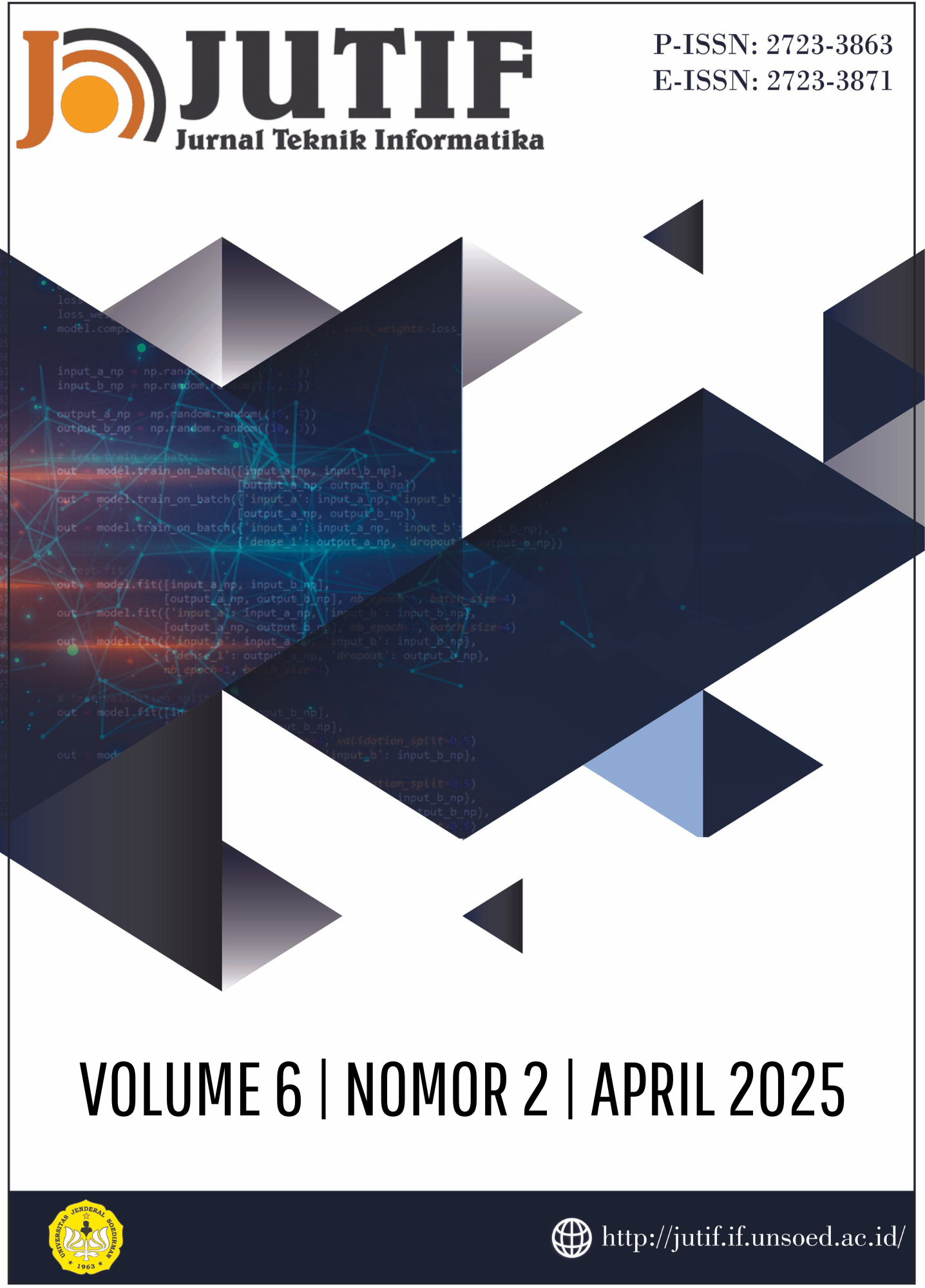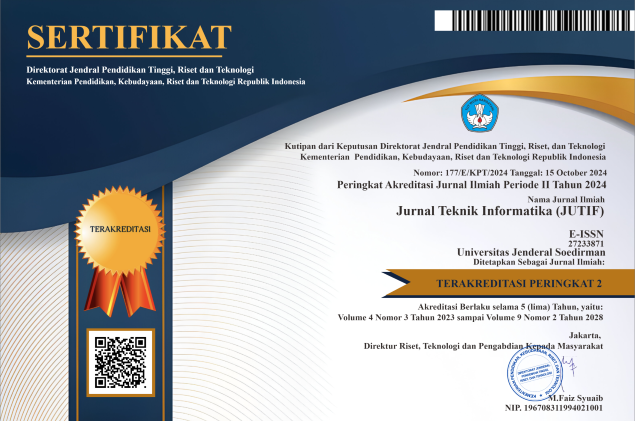Analyzing Blockchain Adoption for Copyright Certification in Lombok's Woven Industry: An Extended TAM Perspective
DOI:
https://doi.org/10.52436/1.jutif.2025.6.2.4366Keywords:
Blockchain, Copyright Certification, Lombok SMEs, PLS-SEM, Technology Acceptance Model, Traditional WeavingAbstract
This research explores the Extended Technology Acceptance Model (TAM) and Partial Least Squares Structural Equation Modelling (PLS-SEM) to investigate the acceptability of blockchain-based digital copyright certification among traditional woven fabric SMEs (Small and Medium Enterprises) in Lombok. This research develops a blockchain-based certification system using NFTs, IPFS, and ECDSA to secure ownership, metadata, and authentication of traditional woven fabrics in Lombok. The problem addressed is the lack of understanding and acceptance of blockchain technology for copyright certification among SMEs, which can impede the protection of their innovations. The aim of this study is to analyze the variables that influence this technology's acceptance and to provide strategies for increasing its adoption. This study explores blockchain-based copyright certification adoption among Lombok's woven fabric SMEs using an Extended TAM with novel variables: Perceived Trust, Privacy, and Government Regulations. Findings from PLS-SEM reveal these, alongside traditional TAM factors, significantly impact adoption. By addressing digital literacy gaps and regulatory challenges, this research provides insights into promoting blockchain adoption through targeted training and outreach, contributing to innovation protection for traditional artisans. A quantitative method was implemented with a validated and reliable surveys distributed both online and offline to SMEs in three main woven villages in Lombok. Data analysis using PLS-SEM revealed significant impacts of perceived usefulness (PU), perceived ease of use (PEOU), Perceived Trust (PT), Government Regulations (GR), Perceived Protection (PP), attitude towards using (ATU), and behavioral intention to use (BITU) on the acceptance of blockchain technology. This study concludes that TAM factors are crucial in evaluating these SMEs' acceptance of blockchain-based copyright certification. Recommendations are provided to enhance SMEs understanding and skills in applying this technology through targeted training and outreach.
Downloads
References
M. Chang, A. C. S. M. Walimuni, M. Kim, and H. Lim, “Technology in Society Acceptance of tourism blockchain based on UTAUT and connectivism theory,” Technol. Soc., vol. 71, no. May,
p. 102027, 2022, doi: 10.1016/j.techsoc.2022.102027.
O. Sohaib, W. Hussain, and M. Mazzara, “A PLS-SEM Neural Network Approach for Understanding Cryptocurrency Adoption,” vol. 8, 2020.
C. Chen, “Extending the Technology Acceptance Model : A New Perspective on the Adoption of Blockchain Technology,” vol. 2023, 2023, doi: 10.1155/2023/4835896.
M. Sciarelli, A. Prisco, and D. Economia, “Factors affecting the adoption of blockchain technology in innovative Italian companies : an extended TAM approach,” vol. 15, no. 3, pp. 495–507, 2022, doi: 10.1108/JSMA-02-2021-0054.
D. Antsipava, J. Strycharz, E. A. Van Reijmersdal, and G. Van Noort, “What drives blockchain technology adoption in the online advertising ecosystem ? An interview study into stakeholders ’ perspectives,” J. Bus. Res., vol. 171, no. August 2022, p. 114381, 2024, doi: 10.1016/j.jbusres.2023.114381.
J. R. Bimantari, N. Alamsyah, S. I. Murpratiwi, and R. Yasirandi, “ANALYZING TECHNOLOGY ACCEPTANCE MODEL FOR LOMBOK TRADITIONAL FOOD
RESTAURANT IN GOFOOD APPLICATION Jurnal Nasional Pendidikan Teknik Informatika : JANAPATI | 281,” vol. 13, no. 2, pp. 280–290, 2024.
A. K. Shrestha, J. Vassileva, S. Joshi, and J. Just, “Augmenting the technology acceptance model with trust model for the initial adoption of a blockchain-based system,” pp. 1–38, 2021, doi: 10.7717/peerj-cs.502.
A. Alharbi and O. Sohaib, “Technology Readiness and Cryptocurrency Adoption : PLS-SEM and Deep Learning Neural Network Analysis,” vol. 9, 2021, doi: 10.1109/ACCESS.2021.3055785.
P. D. Rahman, H. Wijayanto, R. Afwani, M. J. Andara, W. Wesdawara, and A. Zafrullah, “Blockchain-Based Traditional Weaving Certification and Elliptic Curve Digital Signature,” vol. 24, no. 1, pp. 105–116, 2024, doi: 10.30812/matrik.v24i1.4337.
H. Taherdoost, “A Critical Review of Blockchain Acceptance Models — Blockchain Technology Adoption Frameworks and Applications,” 2022.
V. Mezhuyev, M. Al-emran, M. A. Ismail, L. Benedicenti, and D. A. P. Chandran, “The Acceptance of Search-Based Software Engineering Techniques : An Empirical Evaluation Using the Technology Acceptance Model,” pp. 101073–101085, 2019.
U. Wiguna, E. Saputra, and G. S. Darma, “The Intention to Use Blockchain in Indonesia Using Extended Approach Technology Acceptance Model ( TAM ),” vol. 16, no. 1, pp. 27–35, 2022.
C. Gupta, V. Gupta, and A. Stachowiak, “Adoption of ICT-Based Teaching in Engineering : An Extended Technology Acceptance Model Perspective,” vol. 9, 2021, doi: 10.1109/ACCESS.2021.3072580.
A. Legesse, B. Beshah, E. Berhan, and E. Tesfaye, “Exploring the influencing factors of blockchain technology adoption in national quality infrastructure : a Dual-Stage structural equation model and artificial neural network approach using TAM-TOE framework,” Cogent Eng., vol. 11, no. 1, p., 2024, doi: 10.1080/23311916.2024.2369220.
H. Purohit, D. Kalra, and H. K. G. Nair, “Technology Acceptance Model and Attitude of Consumers towards Online Shopping with Special Reference to UAE,” vol. 3, no. 1, 2023.
M. Aminu and N. A. Ahmad, “New Variants of Global-Local Partial Least Squares Discriminant Analysis for Appearance-Based Face Recognition,” vol. 8, 2020, doi: 10.1109/ACCESS.2020.3022784.
W. J. Obidallah et al., “Heliyon Beyond the hype : A TAM-based analysis of blockchain adoption drivers in construction industry,” Heliyon, vol. 10, no. 19, p. e38522, 2024, doi: 10.1016/j.heliyon.2024.e38522.
H. Lee, “Heliyon The acceleration of blockchain technology adoption in Taiwan,” Heliyon, vol. 9, no. 11, p. e21887, 2023, doi: 10.1016/j.heliyon.2023.e21887.
P. B. Patil and M. Sangeetha, “^ ĐŝĞŶĐĞ ŝƌĞĐƚ ^ ĐŝĞŶĐĞ ŝƌĞĐƚ ScienceDirect A Comprehensive Comprehensive Performance Performance Analysis Analysis of of a a Hyperledger Hyperledger Blockchain Network Network for for Cross-Border Cross-Border Fund Fabric-powered Blockchain Fund Transfers Transfers,” Procedia Comput. Sci., vol. 233,
pp. 723–732, 2024, doi: 10.1016/j.procs.2024.03.261.
Y. Maythu, A. O. J. Kwok, and P. Teh, “Heliyon Blockchain technology diffusion in tourism : Evidence from early enterprise adopters and innovators,” Heliyon, vol. 10, no. 2, p. e24675, 2024, doi: 10.1016/j.heliyon.2024.e24675.
E. D. La Cruz, “A Quantitative Study of Cybersecurity Data Analytics System Success Using Partial Least Squares Structural Equation Modeling,” no. June, 2024, doi: 10.13140/RG.2.2.35552.70405.
D. T. Cuong, “Online Impulsive Buying Behavior Using Partial Least Squares Algorithm,” vol. 11, pp. 217–236, 2023, doi: 10.13052/jicts2245-800X.1131.
J. Yuan, S. An, X. Pan, H. Mao, and L. Wang, “A Wave Peak Frequency Tracking Method Based on Two-Stage Recursive Extended Least Squares Identification Algorithm,” IEEE Access, vol. 9, pp. 86514–86522, 2021, doi: 10.1109/ACCESS.2021.3057454.
R. Bandinelli, G. Scozzafava, B. Bindi, and V. Fani, “Cleaner Logistics and Supply Chain Blockchain and consumer behaviour : Results of a Technology Acceptance Model in the ancient wheat sector,” Clean. Logist. Supply Chain, vol. 8, no. August, p. 100117, 2023, doi: 10.1016/j.clscn.2023.100117.
A. A. Monem and K. Shaalan, “Exploring Students ’ Acceptance of E-Learning Through the Development of a Comprehensive Technology Acceptance Model,” pp. 128445–128462, 2019.
J. U. N. Li, “Mobile Payment With Alipay : An Application of Extended Technology Acceptance Model,” IEEE Access, vol. 7, pp. 50380–50387, 2019, doi: 10.1109/ACCESS.2019.2902905.
J. Jang, Y. Ko, and W. O. N. S. U. G. Shin, “Augmented Reality and Virtual Reality for Learning : An Examination Using an Extended Technology Acceptance Model,” vol. 9, 2021, doi: 10.1109/ACCESS.2020.3048708.
W. Yeoh, A. Siew, H. Lee, C. Ng, A. Popovic, and Y. Han, “Examining the Acceptance of Blockchain by Real Estate Buyers and Sellers,” 2023.
D. Mohan, N. Kumar, K. Upreti, and N. Delhi, “Blockchain Adoption for Provenance and Traceability in the Retail Food Supply Chain :,” vol. 18, no. 2, pp. 1–17, doi: 10.4018/IJEBR.294110.
I. Waris, R. Ali, A. Nayyar, M. Baz, R. Liu, and I. Hameed, “An Empirical Evaluation of Customers ’ Adoption of Drone Food Delivery Services : An Extended Technology Acceptance Model,” pp. 1–18, 2022.
A. Yusuf and T. A. Hamit, “Consumers ’ Acceptance of Online Grocery Shopping in a Pandemic Situation : An Extended Technology Acceptance Model Perspective CONSUMERS ’ ACCEPTANCE OF ONLINE GROCERY SHOPPING IN A PANDEMIC SITUATION : AN EXTENDED TECHNOLOGY,” Eur. J. Bus. Sci. Technol., vol. 8, no. 2, pp. 143–158, 2023, doi:
11118/ejobsat.2022.008.
Additional Files
Published
How to Cite
Issue
Section
License
Copyright (c) 2025 Joselina Rizki Bimantari, Heri Wijayanto, Ida Bagus Ketut Widiartha, Royana Afwani

This work is licensed under a Creative Commons Attribution 4.0 International License.



























